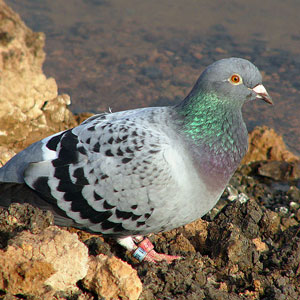Pratique | Débuter
Le rôle de l’odorat dans l’orientation de certains oiseaux

Le Pigeon biset (Columba livia) utiliserait les odeurs pour se repérer.Photographie : Andreas Trepte / Wikimedia Commons
Introduction
La façon dont les oiseaux réussissent à migrer sur de longues distances sans se perdre constitue un mystère pour les biologistes, et diverses hypothèses sur les repères utilisés ont été avancés: repères astronomiques, étude des variations du champ magnétique terrestre, des ultrasons…
Des études, menées depuis les années 1970 (Papi et al) sur le pigeon voyageur, notamment à l’université de Pise (Italie), montrent que les odeurs transportées par le vent pourraient jouer le rôle de repères « olfactifs », l’oiseau se créant de véritables « cartes odorantes ».
Dans cet article, nous vous proposons une présentation de cette hypothèse contestée par certains chercheurs.
Abstract
In Italy (notably in the University of Pisa) and Germany, a long series of experiments has provided evidence that olfactory cues are important to pigeon homing. Birds with their olfactory nerves sectioned neither orient nor home from unfamiliar sites. Pigeons whose exposure to natural air flow has been manipulated by deflector lofts or by tunnels show the predicted deflection of their vanishing directions. Birds transported long distances do not orient unless they are allowed to sample the natural air on the outward journey; filtering the air through charcoal eliminates the pigeons ability to orient. These and many other observations make a convincing case that pigeons make some use of olfactory information in their orientation.
Replications of the experiments in different regions, however, yielded widely differing results. These discrepancies led to the well-known controversy among scientists about the role of olfactory input and its general importance for orientation.
Poursuivez la lecture de cet article, en vous abonnant dès maintenant !
Découvrez les Archives d’Ornithomedia.com
Pour seulement 10,00 €TTC/an (ou 6,00 € les 6 mois)
Profitez de plusieurs centaines d’articles en accès illimité et sans aucun engagement.
Compléments
À lire aussi sur Ornithomedia.com
- L’ouïe : nouvelle théorie pour expliquer l’orientation des pigeons migrateurs ?
- Le rôle du géomagnétisme dans l’orientation des oiseaux
- L’orientation chez les oiseaux
- L’ion superoxyde jouerait un rôle dans l’orientation magnétique des migrateurs
Sources
- Floriano Papi, Giovanna Mariotti, Augusto Foa’, Vittorio Fiaschi, Istituto di Biologia generale dell Università di Pisa: nombreux travaux cités sur le Web
Rossella Lorenzi, « Pigeons smell their way home », Discovery News Friday, 18 August 2006 - « Homing pigeons do extract directional information from olfactory stimuli, Revue Behavioral Ecology and Sociobiology, Numéro Volume 26, Number 5 / mai 1990
- Cordula V. Mora, Michael Davison, J. Martin Wild and Michael M. Walker, Magnetoreception and its trigeminal mediation in the homing pigeon, Nature 432, 508-511(25 November 2004)
Livre recommandé
La navigation du pigeon voyageur : Lumières sur un passionnant mystère de Christophe Arnoult




Aucun commentaire sur ce sujet
Participer à la discussion !